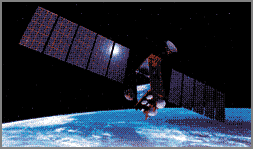Channels in the sky
Broadcasting > Channels in the sky
Satellite Television Program is received from Orbiting Communication Satellites traveling from west to east, about 36,000 km above the Earth’s Equator, Figure 1. At this height, the angular velocities of the Satellite on the Orbit and the Earth’s Rotation are exactly the same, so the Satellite stays over the same point above the Equator and it looks like Stationary. This Orbit is called the Geosynchronous Orbit.

Figure 1: Orbiting Communication Satellites
To Broadcast a TV program, through a normal Telecommunication Satellite, the Earth Station sends it to the Satellite, through an Uplink, within the Frequency range of 5.9 – 6.4 GHz. The Satellite Receives and Amplifies the Broadband Signal and sends it back to Earth, through a Downlink, within the Frequency range of 3.7 – 4.2 GHz. The Frequency range of 3.7 – 6.4 GHz is called C Band. At your home, the Satellite Dish (Antenna) should point directly to the Satellite in order to Receive the Broadband Signal that contains several TV Channels with Sound and Video.
Signals from the Satellite are very weak, so Parabolic Reflectors (Antennas) and Low Noise Receivers are used on the Ground Receiving Equipment, Figure 2. The Parabolic Reflector (Antenna) of the Dish focuses the Signal at the LNB (Low Noise Block Converter), which converts the broadband SHF (Super High Frequency) Signal to lower Frequency. The Receiver decodes the Signal which carries several different Broadcasting Channels.

Figure 2: Parabolic Reflectors (Antennas)
Links
- How Satellite TV Works - Detailed information and theory about satellite TV
- Transmission - Plenty information about TV transmission, with a detailed electromagnetic spectrum
- Frequency Band in Use for Satellite Transmitiones
Broadcasting > Channels in the sky
